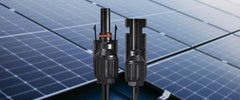
What is a 4-Pin Power Cable for Solar Batteries?
, 3 min reading time


, 3 min reading time
In the ever-evolving world of renewable energy, the demand for reliable solar battery connections has skyrocketed. Solar systems, whether for residential, industrial, or off-grid applications, require robust components to ensure efficiency and longevity. One such component is the 4-pin power cable. This blog explores what a 4-pin power cable is, its functionality, advantages, and why it is indispensable in modern solar setups.
A 4-pin power cable is a specialized cable designed to facilitate secure and efficient power transmission in solar systems. Its construction includes:
Four Distinct Pins: Each pin serves a specific function, such as power delivery, grounding, and data communication.
Durable Outer Casing: Protects the cable from harsh environmental conditions, including UV exposure and moisture.
The primary role of a 4-pin power cable is to connect solar batteries to inverters, charge controllers, or monitoring systems, ensuring seamless power and data transfer.
The effectiveness of a 4-pin power cable lies in its well-thought-out configuration:
Pin Configuration:
Power Pins: Transmit electricity from the solar battery.
Ground Pin: Provides a safe path for excess current, preventing short circuits.
Communication Pin: Enables data transfer for real-time monitoring and diagnostics.
This design allows for simultaneous power and data transmission, optimizing the overall performance of solar energy systems.
Using a 4-pin power cable in solar setups offers numerous benefits:
Efficient Power Transmission: Minimizes energy loss during transfer, enhancing system efficiency.
Enhanced Safety: Dedicated ground and insulated connections prevent overheating and short circuits.
Data Monitoring Capability: Facilitates tracking of battery health and performance in real time.
Durability: Withstands extreme weather conditions, ensuring long-term reliability.
4-pin power cables are versatile and find applications in various solar setups:
Off-Grid Systems: Essential for connecting batteries to inverters and charge controllers.
Smart Battery Management: Supports real-time diagnostics and monitoring.
Industrial Solar Solutions: Ideal for high-capacity systems requiring robust and reliable connections.
Selecting the appropriate 4-pin power cable is crucial for optimal system performance. Key factors to consider include:
Cable Specifications: Ensure the voltage and current ratings match your system’s requirements.
Connector Type: Compatibility with your solar battery and devices is vital.
Weatherproof Design: Opt for cables with weather-resistant features for outdoor setups.
Certifications: Look for UL or CE certifications to guarantee safety and reliability.
Proper installation ensures the cable’s longevity and performance. Follow these steps:
Verify Compatibility: Check that the cable matches your solar battery and other components.
Secure Connections: Ensure all pins are tightly connected to avoid loose ends or short circuits.
Test the Setup: Verify that both power and data transmission are functioning as expected.
Inspect Regularly: Periodically check for wear and tear to maintain efficiency and safety.
Myth: These cables are only necessary for large solar setups.
Fact: They enhance performance and monitoring in both small and large systems.
Myth: Installation is overly complex.
Fact: With proper guidelines, installing a 4-pin power cable is straightforward.
The 4-pin power cable is a critical component in modern solar battery setups, combining efficiency, safety, and data monitoring capabilities. Its robust design ensures reliable operation in diverse conditions, making it suitable for a wide range of solar applications. By understanding its features, advantages, and installation process, you can maximize the performance and longevity of your solar energy system.



